The honey gourami is a vibrant and colorful fish, making it an excellent choice for small nano tanks. Though not as widely known as its close relative, the dwarf gourami, the honey gourami is rapidly gaining popularity among aquarists for its beauty and peaceful demeanor. To ensure these lovely fish thrive, it’s essential to provide proper care and a suitable environment. This includes maintaining stable water conditions and incorporating plants and hiding spots in the aquarium.

Contents
Habitat in the wild
The honey gourami, also known as the sunset gourami, is a captivating freshwater fish from the family Osphronemidae. This species, part of the order Perciformes, is prized for its vibrant colors and peaceful nature, making it a popular choice among aquarists.
As a labyrinth fish, the honey gourami has a unique labyrinth organ that allows it to breathe air directly from the surface, enabling it to thrive in oxygen-poor environments like stagnant ponds and slow-moving streams. Originally described by Francis Hamilton in 1822 as belonging to the Colisa genus, it is now commonly classified within the Trichogaster genus.
Native to the river basins of Northeast India and Bangladesh, including the Ganges and Brahmaputra, honey gouramis are typically found in densely planted waters. They inhabit lakes, ponds, small rivers, flooded fields, and even drains, often in areas susceptible to seasonal droughts from June to October.
These fish prefer soft, low-mineralized water rich in vegetation. As omnivores, honey gouramis enjoy a varied diet that includes insects, larvae, and various zooplankton, making it easy to provide for their nutritional needs in a home aquarium.
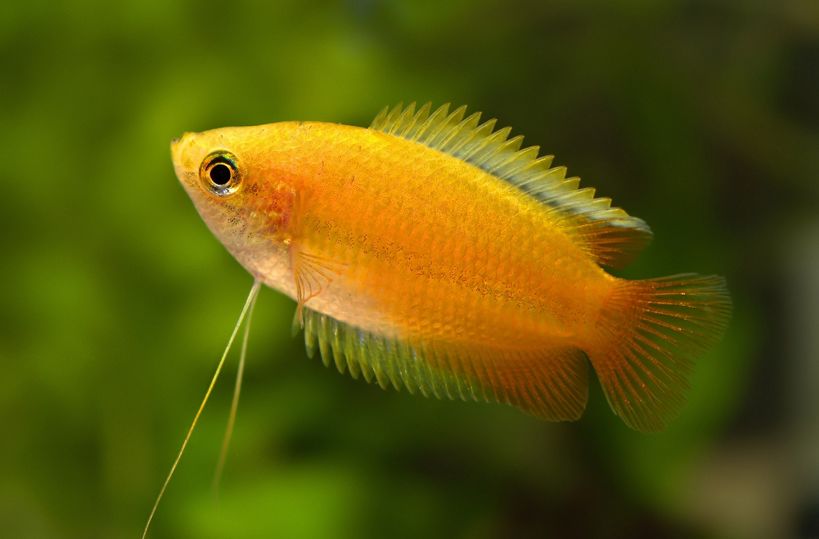
Description
One of the most striking features of the honey gourami is its vibrant coloration. These fish display a stunning range of colors, from golden-yellow to orange, often accented with red or brown hues on their fins and scales. The intensity of their colors can vary among individuals and can change based on mood and surroundings. Males typically exhibit shades from olive brown to bright orange-red, especially during spawning when they display a rich red hue. A dark brown stripe runs from near the eye along the side of the body, while the abdomen is a lighter, silvery color. The dorsal fin edges are lemon-yellow, and the filamentous abdominal fins are bright orange or red. Females share a similar coloration but are generally paler.
Like all gouramis, honey gouramis possess a labyrinth organ, a unique adaptation that allows them to breathe air directly from the water’s surface. This small bony structure sits above their gills, enabling them to thrive in low-oxygen environments.
In terms of lifespan, honey gouramis typically live for about 3 to 5 years in a well-maintained aquarium. With excellent care, including optimal water quality, regular changes, and a balanced diet, they can sometimes reach up to 6 years or slightly longer.
When it comes to size, honey gouramis are relatively small fish. In a home aquarium, they usually grow to around 2 to 2.5 inches (5 to 6.5 cm) in length, with females being slightly smaller than males. Males tend to be thinner and more vividly colored, while their dorsal and anal fin tips are sharper compared to the rounded fins of females.
| Characteristic | Description |
|---|---|
| Scientific Name | Trichogaster chuna |
| Common Names | Honey gourami, Sunset gourami |
| Family | Osphronemidae (Gourami family) |
| Origin | South Asia (India, Bangladesh, Nepal) |
| Size | Approximately 2 to 2.5 inches (5 to 6.5 cm) |
| Lifespan | Around 3 to 5 years (with proper care) |
| Temperament | Peaceful and non-aggressive |
| Coloration | Golden-yellow to orange with red or brown hues |
| Dark Spot | Dark spot on each side of the body, near the tail |
| Fins | Elongated, pointed dorsal and anal fins |
| Body Shape | Slender and streamlined for maneuvering in plants |
| Labyrinth Organ | Allows breathing air from the water’s surface |
| Habitat | Slow-moving waters with dense vegetation |
| Diet | Omnivorous; eats insects, larvae, and plants |
| Tank Compatibility | Peaceful community fish, avoid aggressive species |
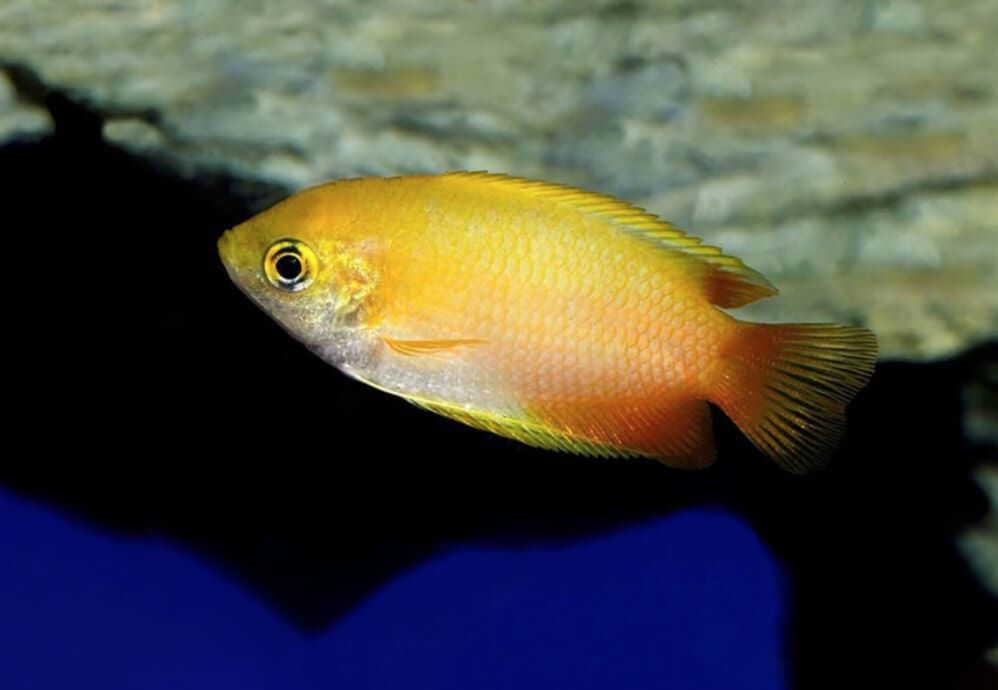
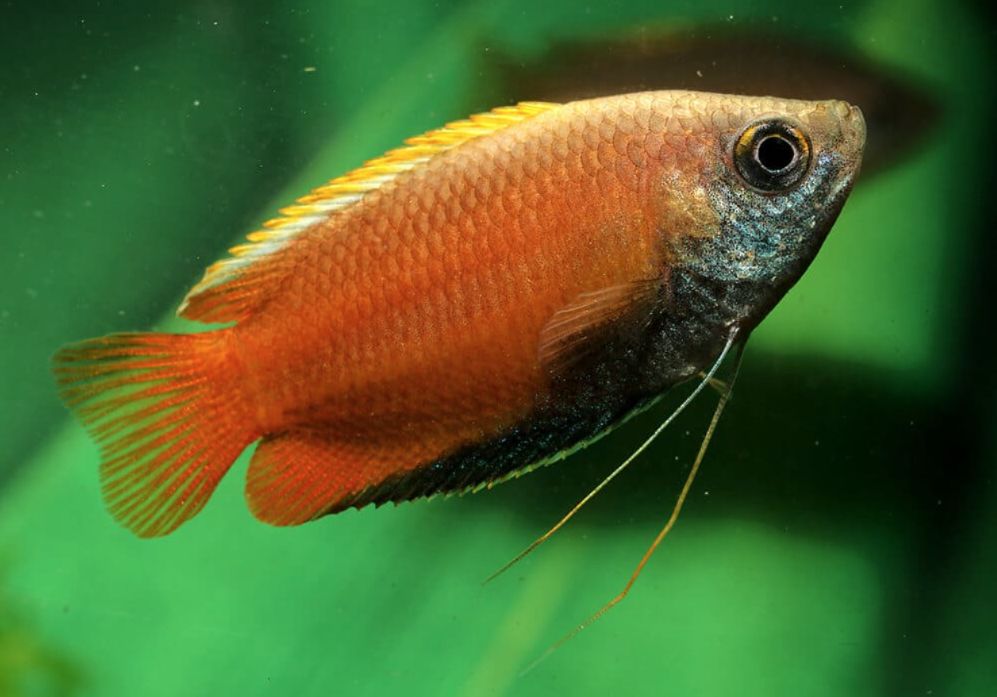
Difficulties in keeping
The honey gourami is an excellent choice for beginner aquarists due to its peaceful nature and vibrant coloration. This small fish adapts well to various water parameters and temperatures, making it versatile for different tank environments.
Known for its timid demeanor, the honey gourami thrives in community tanks where it is welcomed for its non-aggressive behavior. It can also comfortably inhabit smaller tanks, making it a great option for those with limited space. Overall, the honey gourami’s charm and adaptability make it a wonderful addition to any aquarium setup.
Keeping in a tank
Tank size
Honey gouramis can thrive in smaller tanks, but providing a suitable environment is crucial for their well-being. The recommended minimum tank size for a couple or small group of honey gouramis is about 10 to 15 gallons (37 to 57 liters). These fish prefer to swim in the mid to upper water layers, so it’s important to create a well-structured habitat.
However, a larger tank is always beneficial. With a larger aquarium, you can maintain a more stable environment, accommodate additional compatible tank mates, and offer more swimming space for the gouramis to explore. A tank size of 20 to 30 gallons (75 to 114 liters) is ideal, allowing for more decorations, plants, and the potential for a small community of fish that complement the honey gourami’s peaceful nature. Adding plants and hiding spots can enhance their environment, making it both enriching and visually appealing.
Water parameters
These fish are relatively undemanding and can adapt well to various tank conditions. Here are the recommended water parameters for honey gouramis:
Water Changes: Although honey gouramis have a labyrinth organ that allows them to survive in low-oxygen conditions, this does not eliminate the need for regular water changes. Without proper maintenance, they may suffer from toxic build-up of nitrates and ammonia. A weekly water change of 20-25% is recommended, especially in smaller tanks where changes occur more rapidly.
Temperature: The ideal range is between 78°F to 80°F (25.5°C to 26.5°C), but they can thrive in a range from 75°F to 82°F (24°C to 28°C).
pH Level: Honey gouramis prefer slightly acidic to neutral water, ideally around a pH of 7.0. They can tolerate levels from 6.0 to 7.5.
Water Hardness: They do best in soft to moderately hard water, with a general hardness of 2 to 15 dGH (degrees of general hardness).
Ammonia and Nitrites: Both should be kept at 0 ppm, as these substances are toxic to fish. Regular water changes and proper filtration are essential for maintaining safe levels.
Nitrates: Keep nitrates below 20 ppm. While less toxic than ammonia and nitrites, high nitrate levels can still be harmful over time, so regular water changes are important.
Filtration: Use a suitable aquarium filter to maintain good water quality. Gouramis are sensitive to poor conditions, making effective filtration crucial.
Water Movement: Honey gouramis thrive in gentle water movement, so avoid strong currents that may cause stress.
Tank decor
These fish thrive in environments rich with plants, so it’s beneficial to densely plant the back of the tank while leaving open swimming space in the middle. Consider incorporating a variety of aquatic plants, such as Java fern, Amazon sword, Anubias, Vallisneria, and floating plants like water sprite or Amazon frogbit.
Additionally, providing plenty of shelters is important, as honey gouramis are timid and may need places to retreat when feeling stressed. Adding driftwood and rock caves can create secure hiding spots. Beyond functional elements, aesthetic decorations can enhance the tank’s appearance; just ensure they are fish-safe and free of sharp edges that could harm the gouramis.
Honey gouramis also prefer subdued lighting, as they originate from habitats with dappled light filtered through dense vegetation. Using low-intensity lighting and creating shaded areas with floating plants or tall decorations will help replicate their natural environment, promoting comfort and reducing stress.
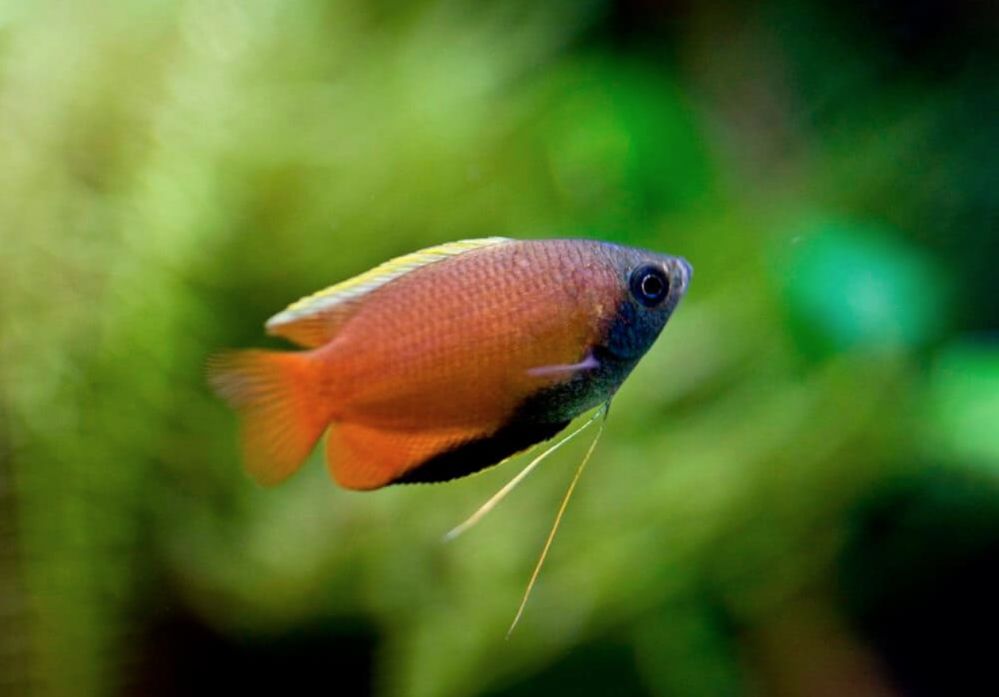
Diet
Honey gouramis are omnivorous fish, thriving on a mix of animal-based and plant-based foods. In their natural habitat, they primarily feed on small insects, insect larvae, crustaceans, and various plant matter found in slow-moving waters with dense vegetation. Providing a balanced diet in an aquarium is essential for their health and vibrant coloration.
For their staple diet, commercially prepared flake or pellet foods specifically designed for tropical fish are ideal. Look for high-quality products that offer a good balance of proteins, fats, and essential nutrients.
Live foods are highly beneficial and can stimulate their natural hunting behavior. Consider offering brine shrimp, daphnia, bloodworms, and mosquito larvae to enhance their diet.
Frozen foods serve as a convenient alternative to live offerings and can be stored easily. Options like frozen brine shrimp and bloodworms add variety and nutrition.
Occasionally, freeze-dried foods such as bloodworms or daphnia can be given as treats to diversify their diet.
To ensure they receive all necessary nutrients, feed honey gouramis small portions multiple times a day, which promotes their overall health and enhances their coloration.
Gender differences: male vs female
Distinguishing between male and female honey gouramis is straightforward, thanks to several key differences in their appearance. Understanding these characteristics can help aquarists choose the right tank mates and manage breeding.
Male Honey Gourami:
- Larger Dorsal Fin: Males typically have a longer and more pointed dorsal fin.
- Brighter Coloration: They exhibit vibrant colors, especially during breeding, with a more pronounced golden-yellow to orange hue.
- Darker Stripes: Males often have thicker and darker vertical stripes, which become more noticeable during mating displays.
- Longer Anal Fin: The anal fin is more elongated and pointed compared to females.
Female Honey Gourami:
- Smaller Dorsal Fin: Females have a smaller, rounder dorsal fin.
- Duller Coloration: They tend to have a paler appearance with less vibrant colors than males.
- Shorter Anal Fin: The anal fin is shorter and more rounded.
- Less Prominent Stripes: Females may have lighter and less distinct vertical stripes.
These differences become especially pronounced during breeding or in optimal conditions.
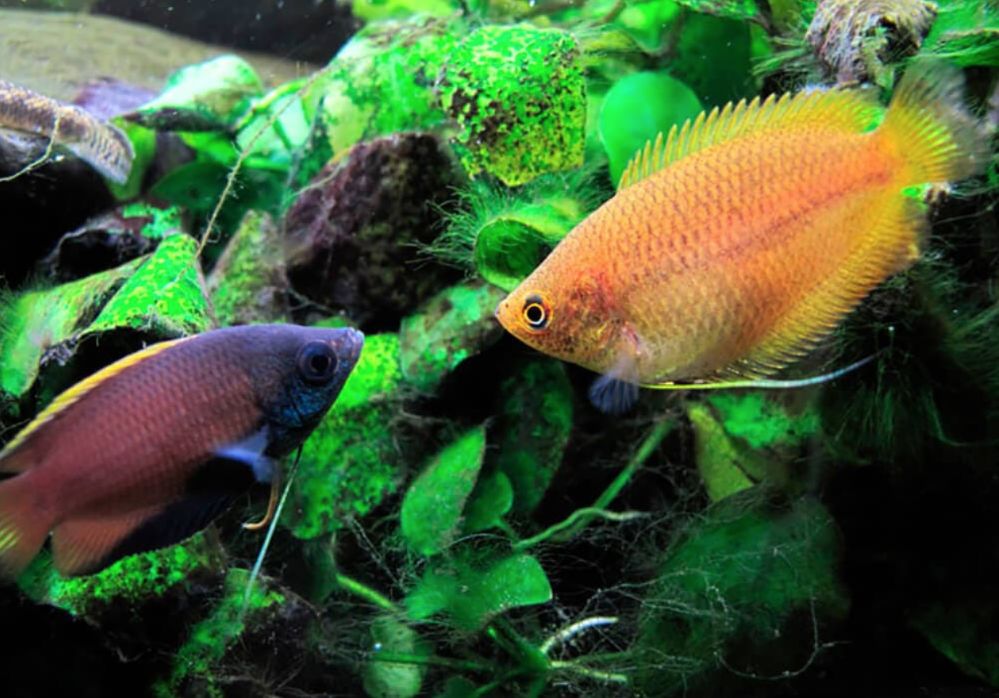
Tank mates
These fish are timid, slow, and fearful, requiring time to acclimate to a new environment. It’s essential to monitor their tank mates to ensure they receive adequate food, as they can be overshadowed by more aggressive fish.
To help honey gouramis feel more secure, densely planted tanks are beneficial, providing hiding spots that reduce stress. These fish are primarily active during the day, so a well-lit environment will encourage their natural behavior.
When selecting tank mates, avoid aggressive species like dwarf gouramis or tiger barbs, as they can nip at the long pectoral fins of honey gouramis and cause stress. Instead, opt for peaceful community fish that will not threaten their well-being.
Many small tetra species make excellent companions for honey gouramis due to their similar peaceful nature and size. Here are some suitable tank mates that can coexist harmoniously with honey gouramis:
- Harlequin Rasboras (Trigonostigma heteromorpha)
- Neon Tetras (Paracheirodon innesi)
- Ember Tetras (Hyphessobrycon amandae)
- Glowlight Tetras (Hemigrammus erythrozonus)
- Black Neon Tetras (Hyphessobrycon herbertaxelrodi)
- Cardinal Tetras (Paracheirodon axelrodi)
- Rummy Nose Tetras (Hemigrammus rhodostomus)
- Sparkling Gouramis (Trichopsis pumila)
- Celestial Pearl Danios (Danio margaritatus)
- White Cloud Mountain Minnows (Tanichthys albonubes)
- Dwarf Rasboras (Boraras spp.)
- Endler’s Livebearers (Poecilia wingei)
- Guppies (Poecilia reticulata)
- Platies (Xiphophorus spp.)
- Corydoras Catfish (Corydoras spp. – pygmy cory, panda cory, adolfoi catfish)
- Otocinclus Catfish (Otocinclus spp.)
- Bristlenose Plecos (Ancistrus spp.)
Breeding
Honey gouramis, like all members of the Anabantidae family, exhibit fascinating breeding behaviors, including the construction of foam nests near the water’s surface. When ready to spawn, the male creates a nest from bubbles and performs a dance to attract the female.
During spawning, the male closely monitors the eggs and maintains the nest’s cleanliness. This process can take several hours, resulting in hundreds of fertilized eggs. After spawning, it’s essential to remove the female, as honey gourami males are more tolerant and respectful of their partners compared to some other species, like dwarf gouramis, which can be aggressive if females aren’t ready to spawn.
The male will position himself vertically in front of the female, guiding her to the nest. Once she enters, they begin spawning, and he carefully collects any eggs that fall outside the nest. The male remains protective of the nest and the fry until the juveniles start swimming. At this point, it’s advisable to remove him as well.
For optimal growth, the juveniles should be fed with infusorians and newly hatched brine shrimp, ensuring they receive adequate nutrition during their early development.